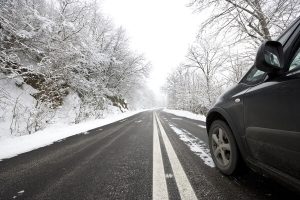Winter Driving Tips
 Before you travel, make sure your car is ready for anything. Here are some tips for Winter Driving Safety from DMV.org
Before you travel, make sure your car is ready for anything. Here are some tips for Winter Driving Safety from DMV.org
Quick checkup
Extremely cold temperatures can quickly deplete a battery, so make sure it is in good shape. A quick tune up at a local service center can help prevent an unforeseen issue.
- Test your battery before any long driving trip
- Check all fluids: oil, windshield, and the heating and cooling systems
Prepare for the Worst
Even though the weather may not look bad when you head out, things can change fast. Have these items on hand just in case conditions get worse:
- Flashlight
- Blanket
- Water
- Sand or salt to help keep your tires from spinning if you get stuck
- Windshield scraper
- Windshield washer fluid
- Plenty of gas
- The extra weight will make it easier to control your vehicle
- Try not to ride with less than a half a tank
- Jumper cables
- Phone charging equipment compatible with your vehicle
Sign Up for Weather Alerts
Check the weather forecasts to avoid harsh weather. But sometimes conditions will change suddenly. By signing up for weather alerts on your smartphone or email, you might be able to avoid changing conditions by altering your route. This could also help you to avoid traffic delays or road closures, which can cause big setbacks.
If you skid
Ice and snow will decrease the traction of your tires, which will make sudden stops and turns more difficult. Sudden braking can cause tires to lock or skid. If you do begin to skid, remember to:
- Pump the brakes
- Shift to neutral
- Control the car by turning the wheel in the direction where you’d like to go
- At the end of the skid, put the car in gear instead of coming to a stop
- Remember to accelerate slowly to keep your traction
Watch Trouble Spots
When it’s raining, snowing, or the temps are below freezing, the roads will be even more dangerous. In bad weather, take extra caution when you encounter:
- Exit ramps
- A turn that’s too sharp or taken at too high of a speed could cause you to lose control if the road is slippery
- Bridges
- These surfaces are the first to freeze
- Black ice
- This transparent ice often looks like nothing more than a wet road
- Look for these spots when temperatures are near freezing
- Intersections
- Brake early when you see stop signs or red lights
Don’t Be Afraid to Stop
Whenever driving conditions become unsafe, pull off the road and wait. Pushing through on roads that haven’t been plowed or a storm that’s taken a turn for the worse will cause more problems in the long run than reaching your destination a little late. Make sure your headlights, brake lights, and hazard lights are clear of snow whenever you stop.
Get Help
If an emergency does occur, here’s what you should remember:
- Call for help
- Keep your cell phone charged just in case you need to make an emergency call in bad weather
- Stay inside
- Leaving your vehicle to look for help can put you in a bad situation
- Stay calm
- Modern technology will make it very likely that someone will know where you are, even if you’ve lost cell phone or radio reception
For the full article click here DMV.org